I see the Stadmuseum sign every time I walk into town, so I figured
today was a good day to check it out. The first exhibit gave a little
bit of ancient Skovde history. In 1904, the people discovered the 1500 year old Timboholm's treasure--Sweden's largest preserved gold treasure (replicated below). I also learned that the town's patron saint is Elin, a woman who was killed in the 12th century while traveling to the inauguration of a church. People made pilgrimages to her tomb, giving rise to the town of Skovde in the 15th century.
The town faced many hardships in its history. First, it was devastated by wars with Denmark in the 16th century and later, it burned down in 1759. These next two photos show models of the town before the fire of 1759 and then after it was rebuilt. The church in the main square is present in both models.
After this exhibition, the museum got a little weird. There were 12 wooden station rooms/modules that featured different exhibitions. It seemed like a combination of modern art and information. They all had interesting architectural features like the ceiling pattern and the lighting in the pictures below.
I couldn't read any of the information, but several topics were sustainability, wooden architecture, and various countries' carbon footprints. I didn't need to know Swedish to understand the message of these graphs pictured below.
In the final part of the museum, there was a huge clutter of old 'stuff.' The room was jam-packed with things, grouped into different categories. There were old cameras, wood working tools, medicinal items, record players, lots of photographs, etc. I included one of my favorite pictures of an old sewing machine. It was fun to poke around and take photos of all the stuff in the museum.
In the afternoon, Lina came to pick up Diane and me to help referee a Brannboll game. I had no idea what that meant, but the game was explained to us by Anzo (our coach), and it seemed simple enough. Basically, a hitter hits the ball and tries to run the bases. If the fielders get the ball to a designated spot and the runner hasn't reached the next base, they go back a base. The bases are far apart and runners can choose to run or not, so there can be a lot of runners at one base. The goal is to score the runners and it is all based on points, which can be earned for offensive or defensive things. Each team hits for 10 minutes and then the teams switch. For more detailed rules, click here.There were four teams so they played a round robin type of tournament. All four teams worked for the same company but represented different departments.
We were the official referees (Diane took the photo). Left to right: Lina, Anzo, Priya and me. It started to rain (obviously) after two full games and it was about 7 degrees, so Diane and I wimped out and went home. It was a really fun game though, so I hope I get to play it at some point!












No comments:
Post a Comment